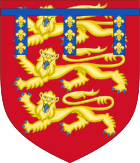
Back Huis van Lancaster Afrikaans أسرة لانكستر Arabic اسرة لانكستر ARZ Lankaster sülaləsi Azerbaijani Ланкастэры Byelorussian Ланкастърска династия Bulgarian Lancaster (dinastija) BS Casa de Lancaster Catalan Lancasterové Czech Lancastriaid Welsh
| House of Lancaster | |
|---|---|
 First house[a]  Second house[b] | |
| Parent house | House of Plantagenet |
| Country | |
| Founded | 1267 |
| Founder | Edmund Crouchback, 1st Earl of Lancaster and Leicester (first house) John of Gaunt, 1st Duke of Lancaster (second house) |
| Current head | Extinct |
| Final ruler | Henry of Grosmont, 1st Duke of Lancaster (first house) Henry VI of England (second house) |
| Estate(s) | England |
| Dissolution | 1361 (last unbroken male heir) 1471 (extinction) |
| Deposition | 1461 (first time) 1471 (final time and extinction) |
| Cadet branches |
|
The House of Lancaster was a cadet branch of the royal House of Plantagenet. The first house was created when King Henry III of England created the Earldom of Lancaster—from which the house was named—for his second son Edmund Crouchback in 1267. Edmund had already been created Earl of Leicester in 1265 and was granted the lands and privileges of Simon de Montfort, 6th Earl of Leicester, after de Montfort's death and attainder at the end of the Second Barons' War.[1] When Edmund's son Thomas, 2nd Earl of Lancaster, inherited his father-in-law's estates and title of Earl of Lincoln he became at a stroke the most powerful nobleman in England, with lands throughout the kingdom and the ability to raise vast private armies to wield power at national and local levels.[2] This brought him—and Henry, his younger brother—into conflict with their cousin King Edward II, leading to Thomas's execution. Henry inherited Thomas's titles and he and his son, who was also called Henry, gave loyal service to Edward's son King Edward III.
The second house of Lancaster was descended from John of Gaunt, who married the heiress of the first house, Blanche of Lancaster. Edward III married all his sons to wealthy English heiresses rather than following his predecessors' practice of finding continental political marriages for royal princes. Henry of Grosmont, 1st Duke of Lancaster, had no male heir so Edward married his son John to Henry's heiress daughter and John's third cousin Blanche of Lancaster. This gave John the vast wealth of the House of Lancaster. Their son Henry usurped the throne in 1399, creating one of the factions in the Wars of the Roses. There was an intermittent dynastic struggle between the descendants of Edward III. In these wars, the term Lancastrian became a reference to members of the family and their supporters. The family provided England with three kings: Henry IV (r. 1399–1413), Henry V (r. 1413–1422), and Henry VI (r. 1422–1461 and 1470–1471).
The house became extinct in the male line upon the death or murder in the Tower of London of Henry VI, following the battlefield execution of his son Edward of Westminster, Prince of Wales, by supporters of the House of York in 1471. Lancastrian cognatic descent—from John of Gaunt and Blanche of Lancaster's daughter Philippa—continued in the royal houses of Spain and Portugal while the Lancastrian political cause was maintained by Henry Tudor—a relatively unknown scion of the Lancastrian Beauforts—eventually leading to the establishment of the House of Tudor. The Lancastrians left a legacy through the patronage of the arts, most notably in founding Eton College and King's College, Cambridge. However, to historians' chagrin, it is Shakespeare's partly fictionalized history plays rather than medievalist scholarly research that has the greater influence on modern perceptions of the dynasty.[3]
Cite error: There are <ref group=lower-alpha> tags or {{efn}} templates on this page, but the references will not show without a {{reflist|group=lower-alpha}} template or {{notelist}} template (see the help page).
- ^ Weir 2008, p. 75
- ^ Jones 2012, p. 371
- ^ Galbraith 1982, pp. 223–239